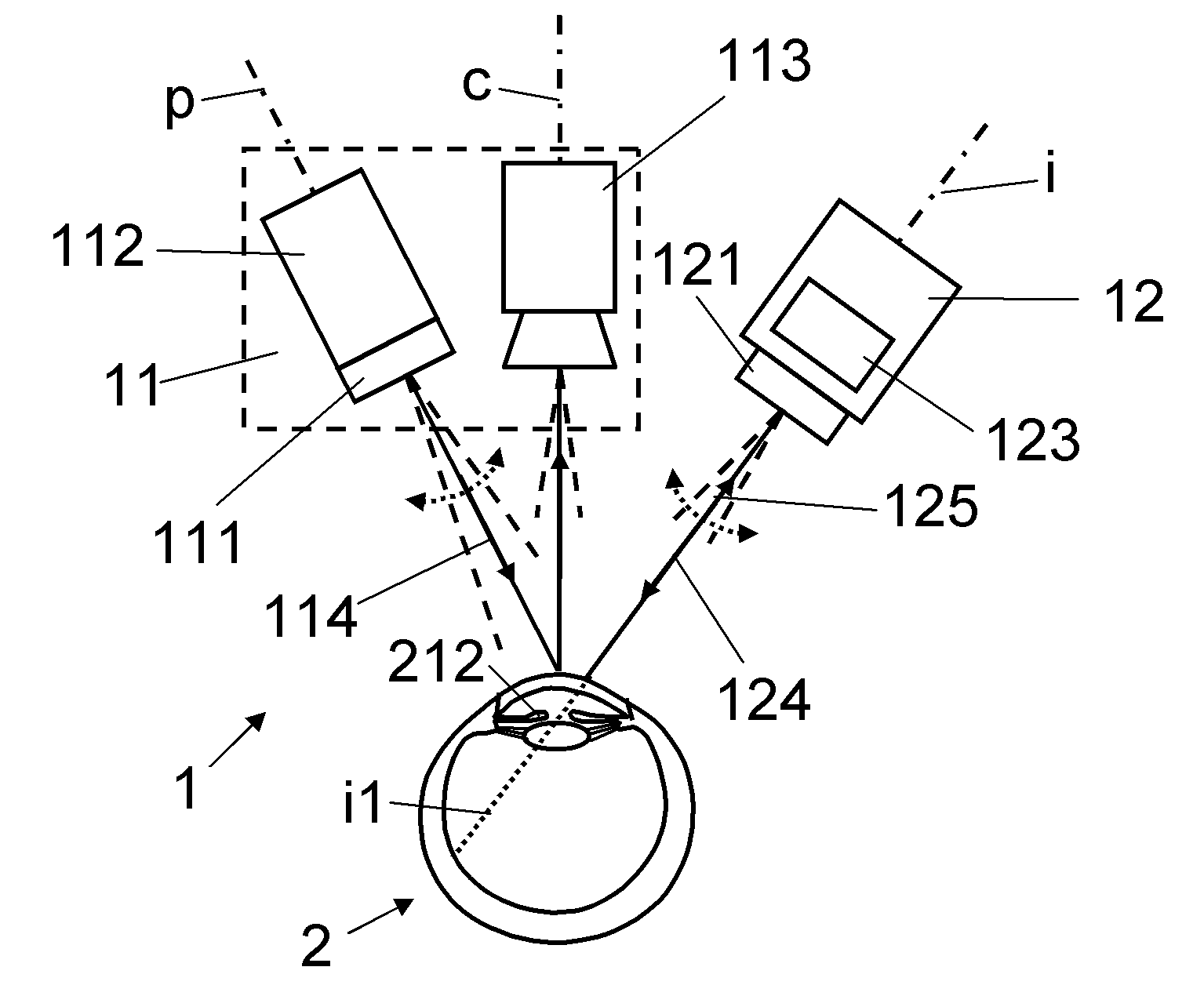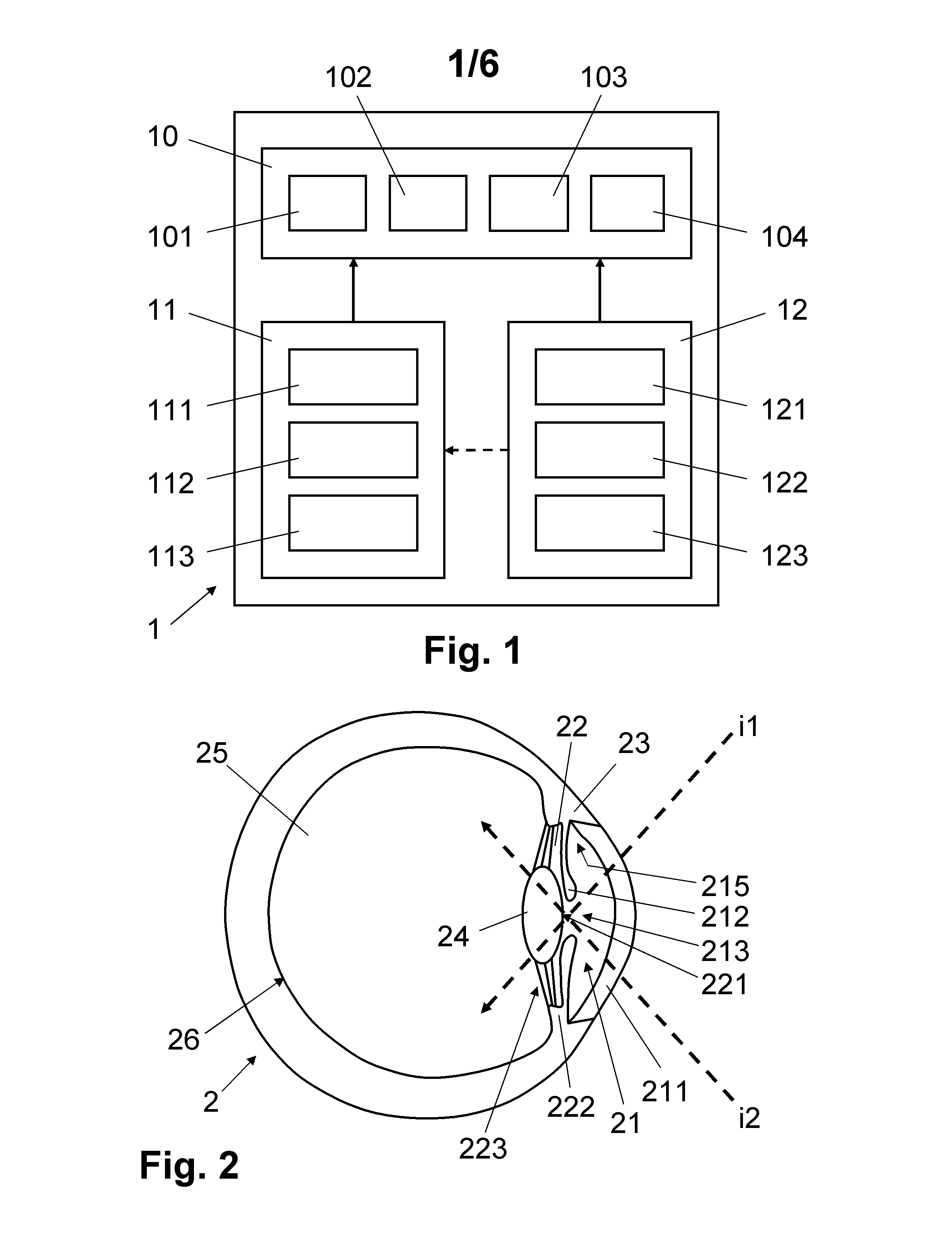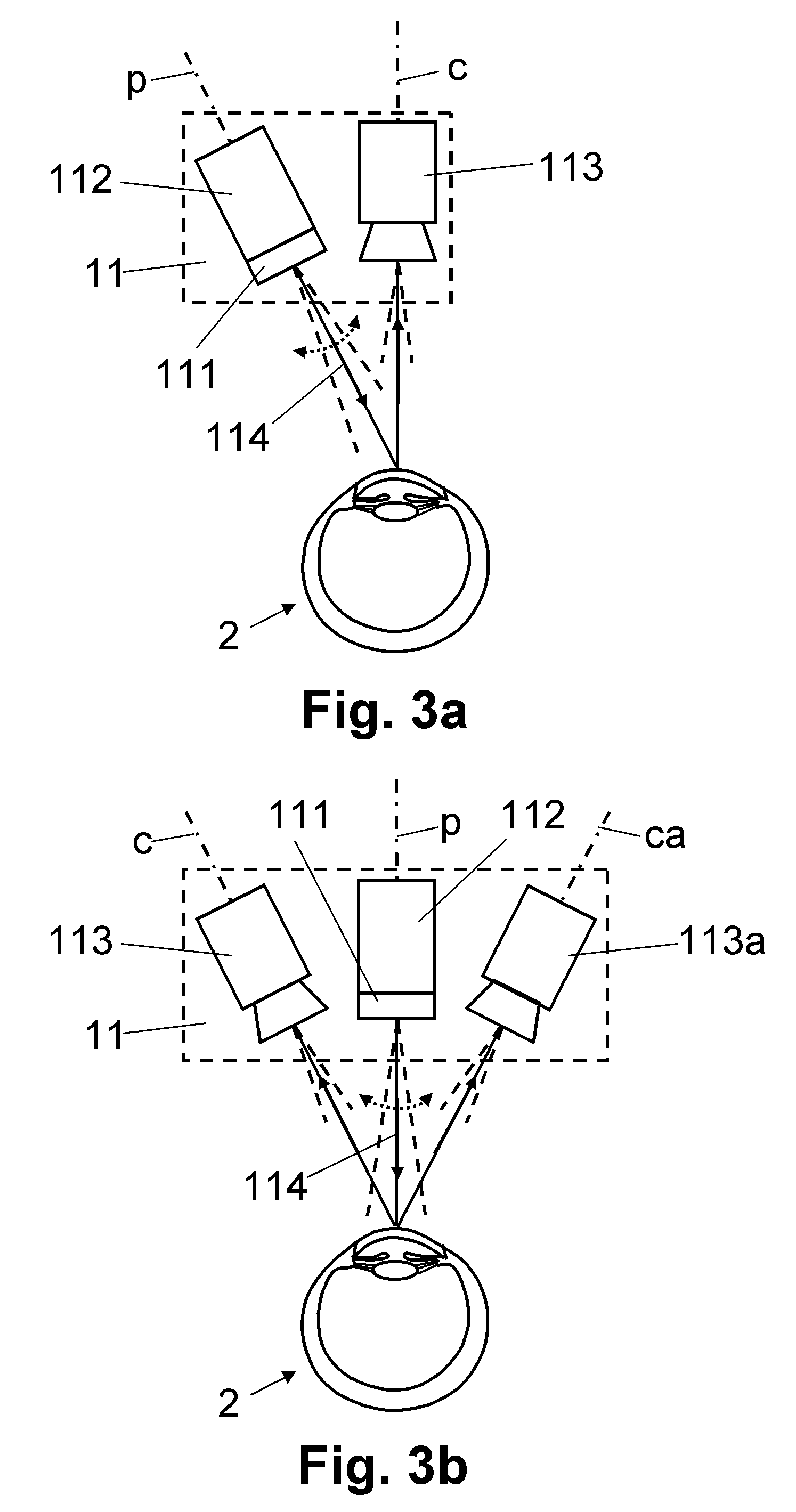[0010]It is an object of the present invention to propose an opthalmological measuring device and an opthalmological measurement method for determining geometric structures of an eye, which do not have at least some of the disadvantages of the known systems. More particularly, it is an object of the present invention to propose an opthalmological measuring device and an opthalmological measurement method for determining geometric structures of an eye, which, on the one hand, are not limited to the visible measurement region of known triangulating measurement methods and, on the other hand, have a reduced impairment of the measurement accuracy by movement artifacts compared to known interferometric methods.
[0012]More particularly, the aforementioned objects are achieved by the present invention by virtue of the fact that an opthalmological measuring device for determining geometric structures of an eye, more particularly geometric structures in the region of the anterior chamber of the eye, includes an optical, triangulating first measurement system for determining at least one geometric reference in the eye by triangulation and an optical, interferometric second measurement system for determining (two- and / or three-dimensional) geometric detailed structures in the eye (particularly in the region of the anterior chamber of the eye) by optical
interferometry, and by virtue of the fact that the measuring device is designed to position the geometric detailed structures determined by the second measurement system on the basis of the at least one geometric reference in the eye determined by the first measurement system. Since triangulating measurement systems, more particularly light-slit- (light-section-) based measurement systems, generate no or only insubstantial movement artifacts (for example, 30 to 60 light-slit recordings suffice for an overall topology of the
cornea in triangulating measurement systems, whereas more than 500 axial measurements on 30 to 60 scan surfaces are needed for this in interferometric measurement), and since interferometric measurement systems can be designed for a detailed measurement region that is smaller compared to the measurement region of the triangulating measurement system but has a high
optical resolution, the positioning of the geometric detailed structures in the eye on the basis of the geometric reference allows a particularly advantageous combination of triangulating and interferometric measurement methods. On the one hand, geometric detailed structures can be registered in the eye by the interferometric measurement system with a high
optical resolution and at positions that are not visible to the triangulating measurement system, and, on the other hand, they can be positioned in the eye on the basis of geometric references, which are determined by the triangulating measurement system without significant movement artifacts. Hence, the advantages of the interferometric measurement system are combined with the advantages of the triangulating measurement system. The reduced impairment in respect of movement artifacts additionally allows the use of cost-effective, slower interferometric (OCT-) techniques (in particular time-domain OCT), which advantageously have greater depth measurement ranges and also allow the use of other wavelengths (in particular wavelengths >1000 nm).
[0013]In one embodiment variant, the first measurement system and the second measurement system are mechanically coupled such that the geometric detailed structures in the eye can be positioned on the basis of one or more geometric settings in a position of the first measurement system (11) corresponding to the geometric reference. In other words, the triangulating measurement system and the interferometric measurement system are set up in a mechanical / geometric fashion, preferably by means of a calibration body, for registering one or more defined geometric references of the eye and the geometric settings are determined from this defined geometric calibration position, which settings define a calibrated relationship between the triangulating measurement system and the interferometric measurement system and, in a defined position of the triangulating measurement system (with respect to the eye), allow a positioning of the geometric detailed structures determined by the interferometric measurement system. An
advantage of this variant is that there is no need for an
image registration and assignment of geometric structure features and positioning of the geometric detailed structures on the basis thereof if the geometric detailed structures are registered by the interferometric measurement system in prompt fashion (i.e. within a defined timeframe) with respect to the setting of the triangulating measurement system corresponding to the geometric reference.
[0014]In a further embodiment variant, the measuring device includes a positioning module designed to determine one or more geometric reference features of the eye and to position the geometric detailed structures on the basis of the geometric reference features in the eye. In other words, the geometric detailed structures are positioned in the eye on the basis of geometric reference features of the eye, which, on the one hand, are determined as a geometric reference by the triangulating measurement system and, on the other hand, are determined in the geometric detailed structures by the interferometric measurement system. An
advantage of this variant is that a user does not need to undertake a mechanical / geometric set-up of the triangulating measurement system with respect to a defined geometric reference of the eye before the interferometric measurement system can register the geometric detailed structures as a result of this. That is to say the triangulating and the interferometric measurement methods can be carried out (temporally) independently of one another without bothersome influences of eye movements, that is to say both in parallel / simultaneously and sequentially and deferred.
[0018]In a further embodiment variant, the first scan module is designed to move the light slit by rotation about a
rotational axis substantially running in the light slit, and the second scan module is designed to move the
light beam in a scan plane, with a
central projection axis of the second scan module forming an angle with the
rotational axis or running along the
rotational axis. Scanning the eye by rotating the light slit allows a particularly simple embodiment of the triangulating measurement system, without deflection mirrors or translational movement drivers.
 Login to View More
Login to View More  Login to View More
Login to View More 


